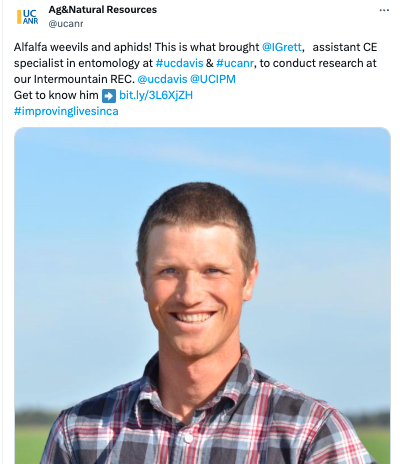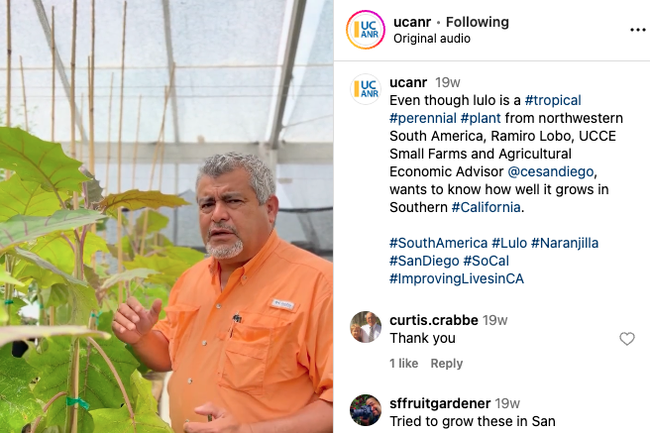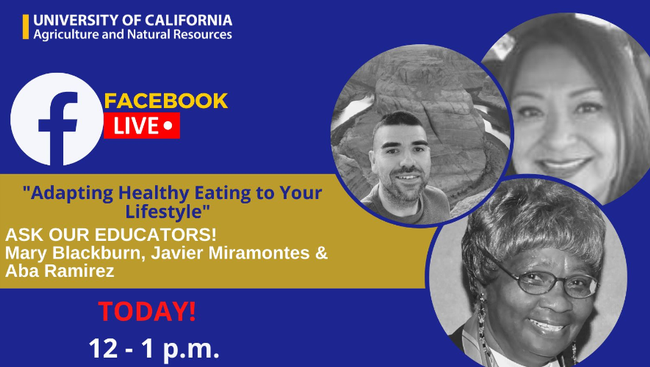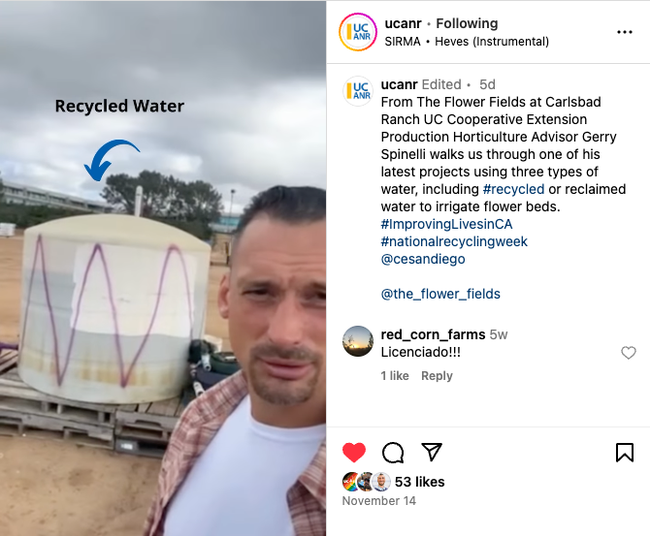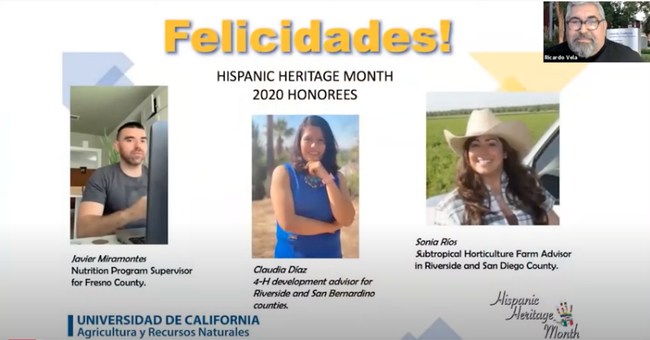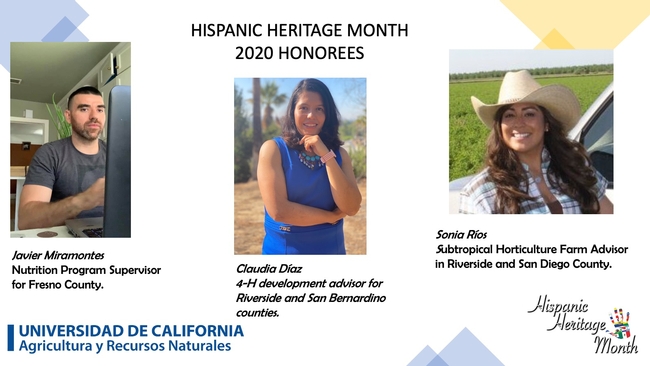- Author: Pamela S Kan-Rice
To increase awareness of how UC ANR research and extension is improving life for Californians, Strategic Communications has been posting about UC Cooperative Extension activities across social media.
Inspired in 2022 by the state government boosting ANR's budget to allow the hiring of more than 100 academics and support staff, Doralicia Garay, social media strategist, wanted to show legislators and other Californians how they benefit from ANR.
“The ‘Improving Lives in California' campaign is designed to showcase ANR research as well as those who deliver it by featuring compelling content and UC Cooperative Extension advisors and specialists,” Garay said.
She targeted Californians who were interested in agriculture, pests, environment, wildfire, water, youth development, and nutrition with paid campaigns as well as regular posts on Facebook, Instagram, X (formerly Twitter) and LinkedIn.
Between March 2022 and December 2023, UC ANR's “Improving Lives in California” campaign has reached more than 600,000 people and more than 21,000 people have engaged with the posts by sharing, liking or commenting across all platforms.
“The per-post engagement rate averaged 3.5% across all social media channels, which is almost twice the average rate per post,” Garay said.
Key elements of the campaign:
- Employee spotlights: Through a series of engaging profiles, we highlight our extension experts' unique journeys and expertise. By featuring their skills and contributions to research projects, we humanize our staff and inspire a sense of connection with our online community.
Examples:
tinyurl.com/23bjz4xr Brooke Latack
tinyurl.com/yxbmybp5 Ian Grettenberger
tinyurl.com/rndcn6uz AtefSwelam
- Short videos: Bite-sized videos featuring Cooperative Extension advisors are intended to simplify complex research projects and explain their relevance to all Californians. It's also a great opportunity for our audiences to get a sense of our researchers' personality.
Examples:
tinyurl.com/mr46w65s Srabani Das
tinyurl.com/bdf68sh5 Ramiro Lobo
Series of videos: instagram.com/ucanr/reels/?hl=en
- Social media takeovers: We take our audience on a virtual tour behind the scenes of our research facilities. Through carefully crafted multimedia content, we share what makes research and extension centers and county office locations unique, and how the infrastructure enables scientists to bring innovation to life.
Example:
tinyurl.com/272xh9h7 South Coast REC
- Research impact stories: We bring our research to life by illustrating its real-world impact on California communities. Through compelling narratives, we demonstrate how the dedication of UC ANR employees to research translates into positive change with advancements in agriculture, wildfire mitigation, water issues and more.
Examples:
tinyurl.com/5y2vn4rs Hamutahl Cohen
tinyurl.com/2e3bafh3 Houston Wilson, Jhalendra Rijal and David Haviland
- Interactive Q&A sessions: Live Q&A sessions on social media platforms encourage direct interaction between our experts and online audiences. Although social media reach has recently dipped for this type of content on Facebook, we successfully engaged with our Facebook audience in 2022 during a nutrition Q&A by retaining 80% of our live audience from start to finish.
Example:
tinyurl.com/52e7jy6s Mary Blackburn, JavierMiramontes andAba Ramirez
- Employee-generated content: Encouraging employees to share their own perspectives, experiences and insights on social media platforms promotes a sense of ownership and inclusivity. It also creates a vibrant online community that encourages our audiences to participate in conversations about research initiatives.
Example:
tinyurl.com/587jcxvf GerrySpinelli
- Hashtag campaign: "#ImprovingLivesinCA is a unique campaign hashtag that serves as a unifying element, allowing us to gather user-generated content and track the campaign's reach and engagement.
“By strategically highlighting our employees in the narrative of our research efforts, #ImprovingLivesinCA strengthens the UC ANR brand identity and positions our organization as a collaborative partner at the forefront of innovation,” Garay said. “This campaign represents a comprehensive approach to leveraging the power of social media to drive reach and engagement and serve our online community.”
You can follow UC ANR on Facebook, Instagram, X (formerly Twitter),LinkedIn and YouTube.
- Author: Pamela Kan-Rice
UC ANR is celebrating Hispanic Heritage Month Sept. 15 to Oct. 15. Each Friday during the celebration, Ricardo Vela, manager of News & Information Outreach in Spanish, is hosting online forums.
“I think this is an excellent opportunity for all of us at UCANR to educate ourselves about ethnic groups,” Vela said. “Learning about the struggles of the Latino community is to learn about the history of our country. The knowledge becomes critical for serving all Californians since Latinos are part of every layer of our society.”
Oct. 2, from 3 p.m. to 4:30 p.m., Vela will discuss the Chicano Moratorium of 1970 with Isidro D. Ortiz, Ph.D., professor of Chicana and Chicano Studies at San Diego State University, and Christian Ramirez, director of the Southern Border Communities Coalition and human rights director of Alliance San Diego
Oct. 9, from 3 p.m. - 4:30 p.m., two journalists from Univision and a farm worker's human rights activist share their experiences with the pandemic, the impact of COVID-19 in the Hispanic community, and why they think Latinos have been hit hard by the disease.
During the first group activity, participants discussed the Mexican American deportation that occurred between 1929 and 1936 with San Diego State professor Ortiz. They also discussed the terms Latinx, Hispanic and Chicano.
During the second session, participants met UC ANR Hispanic Heritage Month honorees Claudia Diaz, 4-H youth development advisor for Riverside and San Bernardino counties; Sonia Ríos, subtropical horticulture advisor for Riverside and San Diego counties; and Javier Miramontes, nutrition program supervisor for Fresno County.
The three spoke candidly about their experiences growing up in Mexico and in the U.S., family support as they pursued higher education and the communities they serve on behalf of UC ANR. Ríos, whose parents were farmworkers, said field workers know agriculture. “We need to listen to them,” she said.
During the uplifting forum, friends and family members of Diaz, Ríos and Miramontes spoke proudly of their accomplishments. A representative of the Mexican consulate congratulated all three honorees.
For more information about upcoming events and to register, visit https://ucanr.edu/sites/Spanish/Hispanic_Heritage_Month/Hispanic_Heritage_Month_2020/Zoom_Forums_Calendar.
- Author: Ricardo Vela
Hispanic Heritage Month, Sept. 15 to Oct. 15, is a celebration is to recognize Hispanics' contributions and vital presence in the United States.
President Lyndon Johnson first approved Hispanic Heritage Week in 1968 and it was expanded to a full month by President Ronald Reagan. Hispanic Heritage Month was officially enacted as a law on August 17, 1988.
As part of this celebration, we are recognizing three Latino professionals who serve their communities while always upholding UC ANR's values of academic excellence, honesty, integrity and community service.
This year UC ANR recognizes
Claudia Diaz Carrasco, 4-H youth development advisor for Riverside and San Bernardino counties. Diaz has received numerous awards and recognitions for her work with underprivileged youths in urban areas. She has worked with UC ANR for five years.
Sonia Ríos, UC Cooperative Extensionsubtropical horticulture advisor for Riverside and San Diego counties. Since an early age, Ríos knew her future was in agriculture. Her grandfather and her father worked in agriculture and nurtured her love for nature and the fields. She has worked with UC ANR for almost nine years.
Javier Miramontes, UCCE nutrition program supervisor for Fresno County. Miramontes enjoys the opportunity his work gives him to serve the community where he grew up. He finds it very rewarding to teach parents, senior citizens and high school students about the importance of a healthy diet and how to create a sustainable environment. He has worked with UC ANR for over five years.
We have several events planned for Hispanic Heritage Month and invite you to participate. See below and the calendar of events at https://ucanr.edu/sites/Spanish/Hispanic_Heritage_Month/Hispanic_Heritage_Month_2020/Zoom_Forums_Calendar.
|
Documentary: The Mexican Repatriation |
The Mexican Repatriation
There was a mass deportation of Mexicans and Mexican Americans from the United States between 1929 and 1936. Estimates of how many people were repatriated range from 400,000 to 2 million. An estimated 60% of those deported were birthright citizens of the United States.
|
Meet the HHM 2020 Honorees |
UC Agriculture and Natural Resources joins the Hispanic Heritage Month celebration by recognizing three Latino academics or educators who serve their communities while upholding UC ANR's values of academic excellence, honesty, integrity and community service.
This year UC ANR recognizes
- Claudia Diaz - UCCE 4-H Youth Development advisor for Riverside and San Bernardino counties
- Sonia Ríos - UCCE subtropical horticulture advisor for Riverside and San Diego counties
- Javier Miramontes - Nutrition program supervisor for Fresno County
|
Documentaries: The Chicano Moratorium & the Zoot Suit Riots |
On August 29, 1970, a "Chicano Moratorium" against the Vietnam War was held in East Los Angeles Loyola-Marymount film student Tom Myrdahl shot this documentary, capturing the events that unfolded as law enforcement and protesters clashed in and around Laguna Park. This documentary was kept hidden from public view for almost 40 years. Myrdahl offers this historical film on the web as a tribute to the brave citizens of East L.A. who came together 50 years ago to voice their dissent against the Vietnam War.
The Zoot Suit Riots were a series of conflicts on June 3–8, 1943, in Los Angeles, which pitted American service members stationed in Southern California against Mexican American youths who were residents of the city. The Zoot Suit Riots were related to fears and hostilities aroused by the coverage of the Sleepy Lagoon murder trial, following the killing of a young Latino man in what was then an unincorporated commercial area near Los Angeles. The riot appeared to trigger similar attacks that year against Latinos in Chicago, San Diego, Oakland, Evansville, Philadelphia, and New York City. The defiance of zoot suiters became inspirational for Chicanos during the Chicano Movement.
|
Covid-19 and Hispanics |
Join a discussion with two journalists from Univision and a farmworker human rights activist. They will share their experiences with the pandemic, the impact of COVID-19 in the Hispanic community, and why they think Latinos have been the ethnic groups hit hardest in the southern United States.


